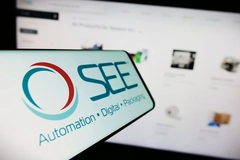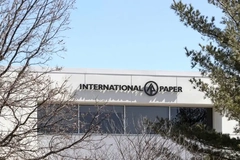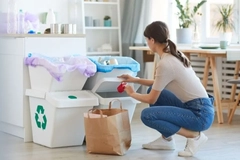Frozen food packaging: Automation, circularity and sustainable materials reduce waste

The frozen food packaging sector is shaped by growing consumer expectations around convenience, sustainability, and performance. In response, the industry is adopting innovative materials, increasing automation, and advancing circularity.
Packaging Insights speaks with experts at ExxonMobil, Gerhard Schubert, Smurfit WestRock, Sacmi, and ProAmpac about their latest developments and emerging trends.
Alex Keane, senior marketing manager for consumer packaging at ExxonMobil, tells us that the key consumer trends driving frozen food innovation are the growing demand for “fast-preparation” meals and buyers looking for healthy choices perceiving “frozen food as a better solution than cans.”
Jan Kaprhal, regional innovation manager at Smurfit Westrock, adds: “The frozen food sector is growing steadily, and the increasing demand for convenience is driving growth prospects in the global frozen food market. Frozen food consumption is increasing due to net income growth, fast-paced lifestyles, and higher living standards.”
Meanwhile, Keane estimates that over 70% of the laminated freezer film market is in the Asia-Pacific region, while over 40% of the non-laminated freezer film market is in the EU. “Asia-Pacific, the Middle East, and Africa will have the strongest growth rate moving forward.”
Bärbel Beyhl, executive assistant and marketing communication at Gerhard Schubert, says: “We are currently seeing a growing trend toward sustainability: the demand for recyclable and low-plastic packaging is increasing significantly. At the same time, innovative hybrid materials such as cardboard with a thin PE barrier or paper-based flow packs are gaining in importance.”
Regarding trends in packaging for frozen food, Keane says that linear low-density PE (LLDPE) is increasingly favored over linear density PE (LDPE). He adds that oriented PP (OPP), OPET (Oriented PET), and OPA (Nylong) are commonly used as substrates.
Legislation pushes sustainability
When it comes to packaging frozen food products, such as ice cream, Gerhard Schubert’s Beyhl says companies are currently facing various challenges, such as the need to develop “more sustainable packaging that fulfils the high requirements for barrier properties and sealing seams to ensure the cold chain despite the reduced use of materials.”
 Gerhard Schubert helps frozen food brands ensure efficient secondary packaging with versatile robots (Image credit: Gerhard Schubert).“The EU Packaging and Packaging Waste Regulation (PPWR) requires a fundamental rethink in packaging design to improve recyclability and reusability. At the same time, these framework conditions open up attractive opportunities: brands can differentiate themselves from their competitors with innovative, sustainable packaging solutions,” she says.
Gerhard Schubert helps frozen food brands ensure efficient secondary packaging with versatile robots (Image credit: Gerhard Schubert).“The EU Packaging and Packaging Waste Regulation (PPWR) requires a fundamental rethink in packaging design to improve recyclability and reusability. At the same time, these framework conditions open up attractive opportunities: brands can differentiate themselves from their competitors with innovative, sustainable packaging solutions,” she says.
ExxonMobil’s Keane points out that “sustainability requirements point toward the growing need to create monomaterial freezer film solutions.”
“We are seeing a migration from complex laminated metallized freezer films to coextruded unlaminated monomaterial PE film to improve potential recyclability.”
“This boost in film performance eliminates the need for lamination and allows for downgauging opportunities and enhances recyclability, contributing to more circular flexible packaging.”
Herbert Hahnenkamp, Packaging and Chocolate general manager for the DACH region at Sacmi, adds: “The future points toward increased use of recyclable materials and the integration of reusable transport packaging within closed-loop logistics systems. We anticipate a stronger push for circular packaging models, where cartons and transport boxes are designed for multiple use cycles, reducing waste and improving sustainability across the supply chain.”
Keane says that performance polymers are a key opportunity for frozen food packagers as they provide “improvements such as the opportunity to downgauge, enhanced package integrity, and the capability to improve shelf appeal.”
“Three and five-layer machines dominate this segment. Seven-layer machines are also expected to become an alternative in the future.”
Paper-based solutions
Smurfit Westrock produces a paper-based material that can be recycled while maintaining the required temperature over extended periods.
The company produced a kraft substrate and tested it in its International Safe Transit Association-certified lab. The test is said to have demonstrated the material’s ability to keep the ingredients under 8 degrees Celsius for over 30 hours.
 Smurfit Westrock's cardboard packaging for frozen Alaskan Fisherman fish (Image credit: Smurfit Westrock).“We offer a wide range of paper-based solutions for frozen foods, including ready-meal cartons, oil- and grease-resistant packaging that maintains their integrity in the face of acute temperature and humidity fluctuations,” Kaprhal says.
Smurfit Westrock's cardboard packaging for frozen Alaskan Fisherman fish (Image credit: Smurfit Westrock).“We offer a wide range of paper-based solutions for frozen foods, including ready-meal cartons, oil- and grease-resistant packaging that maintains their integrity in the face of acute temperature and humidity fluctuations,” Kaprhal says.
The company says it uses “proven” scientific methods backed up by data to design custom frozen food packaging solutions that are visually appealing and expertly engineered to deliver the right solution for our customers’ frozen products. “Our frozen food packaging is designed to withstand the stresses of the supply chain while still appealing to shoppers in-store.”
“One example is the packaging we created for the company, Alaskan Fishermen, who sustainably fish wild Alaskan fish and ship them to the Czech Republic. They wanted to replace the expanded PS box they were using with a sustainable alternative that would retain the same insulation properties. It was vital that the box could keep the fish frozen for four to eight hours during the final part of the supply chain.”
“We created an offset printed Thermobox cardboard box with hexacomb inserts and the story of the Alaskan Fisherman company beautifully displayed on the inside. The new solution was fully recyclable and kept the fish perfectly frozen.”
Durability to reduce waste
Smurfit Westrock’s Kaprhal says that growing consumer concern over food waste is pushing the packaging leader to focus on frozen food solutions that offer extended shelf life, especially for vegetables.
Smurfit Westrock has provided frozen packaging solutions to Mindful Chef, a leading UK recipe box provider, recognized as climate-neutral since 2020.
Keane outlines that ExxonMobil’s “signature” PE portfolio includes Exxtra Seal, Exceed Tough+, Exceed Flow, and Exceed performance polymers. He says they deliver laminated and non-laminated freezer films with exceptional integrity that can withstand very low temperatures for reduced food waste.
At the same time, Gerhard Schubert says it aims to tackle waste and ensure efficiency through its digital services, such as Schubert Care. “By ensuring maintenance, performance tracking, and transparency in energy consumption, these services contribute to optimized processes in the long term, which reduces waste and conserves resources.”
Automation for fine-tuning
Gerhard Schubert’s Beyhl says that modern robot-assisted packaging systems can facilitate smaller pack batches and rapidly changing varieties economically and with flexibility.
 ExxonMobil's recyclable flexible plastic frozen vegetable packaging for Bonduelle (Image credit: ExxonMobil).“Advancing digitalisation also offers great potential, for example through the optimisation of overall equipment effectiveness, better energy transparency and more precise process control.”
ExxonMobil's recyclable flexible plastic frozen vegetable packaging for Bonduelle (Image credit: ExxonMobil).“Advancing digitalisation also offers great potential, for example through the optimisation of overall equipment effectiveness, better energy transparency and more precise process control.”
“Our robot-assisted pick-and-place systems, supported by modern image processing, enable particularly gentle handling of sensitive ice cream products. Thanks to short changeover times, our machines can be flexibly adjusted to a wide range of products and packaging formats, whether for disposable carton packaging or sustainable reusable plastic packaging.”
Gerhard Schubert uses additive manufacturing (3D printing) to implement new product formats, such as innovative shapes, “quickly and economically.”
The company’s Dotlock technology offers “glue-free and easily recyclable” cardboard transport packaging that meets PPWR requirements.
Sacmi’s Hahnenkamp adds: “Cobots, enhanced with AI-driven optimization, play a crucial role in addressing contemporary challenges, such as balancing speed, customization and reliability. These technologies enable smarter, more adaptive packaging lines that can self-adjust for efficiency, reduce downtime, and support a wider range of product formats with minimal human intervention.”
A ProAmpac spokesperson says: “Today’s freezer aisle is a battleground for attention. That’s why we pair technical excellence with visual impact. Our award-winning HD flexographic printing brings brands to life with bold, high-resolution graphics that grab consumers even through frosty glass doors.”
“We also understand that one size doesn’t fit all. Whether it’s a family-size tub or a single-serve novelty bar, our customizable film extrusion technologies let you fine-tune barrier performance and stiffness to suit every format and brand story.”











